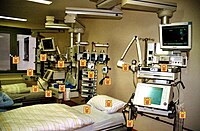
Photo from wikipedia
Abstract Previous studies have suggested that a hospital patient's risk of developing healthcare facility-onset (HCFO) Clostridioides difficile infections (CDIs) increases with the number of concurrent spatially proximate patients with CDI,… Click to show full abstract
Abstract Previous studies have suggested that a hospital patient's risk of developing healthcare facility-onset (HCFO) Clostridioides difficile infections (CDIs) increases with the number of concurrent spatially proximate patients with CDI, termed CDI pressure. However, these studies were performed either in a single institution or in a single state with a very coarse measure of concurrence. We conducted a retrospective case-control study involving over 17.5 million inpatient visits across 700 hospitals in eight US states. We built a weighted, directed network connecting overlapping inpatient visits to measure facility-level CDI pressure. We then matched HCFO-CDIs with non-CDI controls on facility, comorbidities and demographics and performed a conditional logistic regression to determine the odds of developing HCFO-CDI given the number of coincident patient visits with CDI. On average, cases' visits coincided with 9.2 CDI cases, which for an individual with an average length of stay corresponded to an estimated 17.7% (95% CI 12.9–22.7%) increase in the odds of acquiring HCFO-CDI compared to an inpatient visit without concurrent CDI cases or fully isolated from both direct and indirect risks from concurrent CDI cases. These results suggest that, either directly or indirectly, hospital patients with CDI lead to CDIs in non-infected patients with temporally overlapping visits.
Journal Title: Epidemiology and Infection
Year Published: 2022
Link to full text (if available)
Share on Social Media: Sign Up to like & get
recommendations!